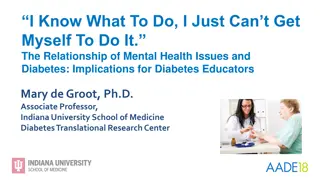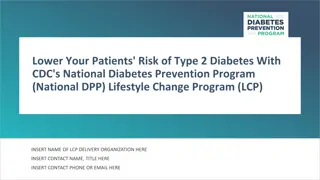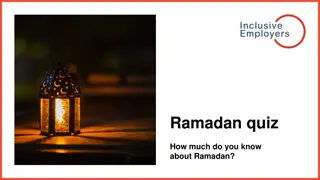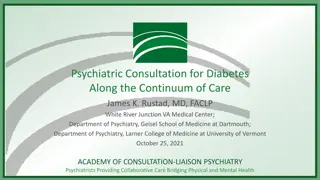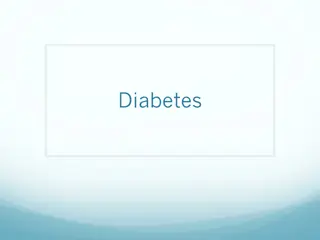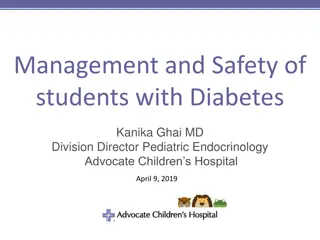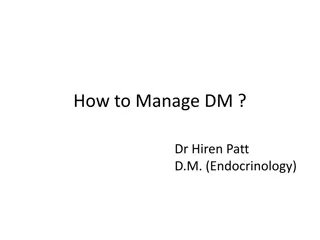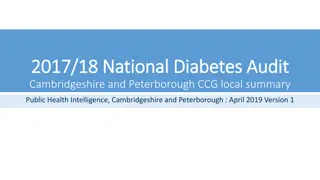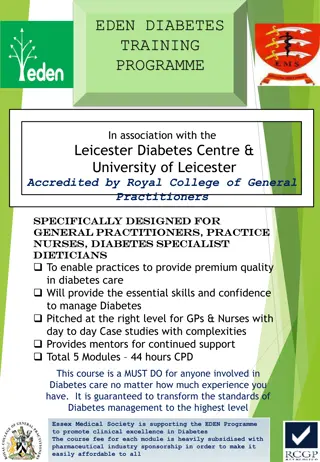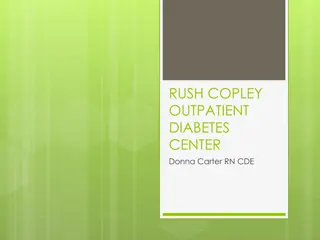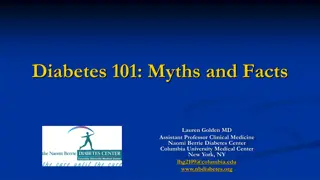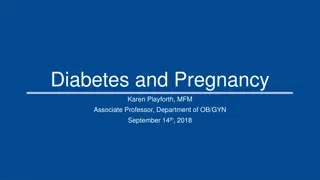Evidence- Based Management of Diabetes During Ramadan
Helpful insights from population-based studies on managing diabetes during Ramadan, including fasting trends, treatment adjustments, hypoglycemia risks, and recommendations for patients with type 1 and type 2 diabetes.
Download Presentation

Please find below an Image/Link to download the presentation.
The content on the website is provided AS IS for your information and personal use only. It may not be sold, licensed, or shared on other websites without obtaining consent from the author.If you encounter any issues during the download, it is possible that the publisher has removed the file from their server.
You are allowed to download the files provided on this website for personal or commercial use, subject to the condition that they are used lawfully. All files are the property of their respective owners.
The content on the website is provided AS IS for your information and personal use only. It may not be sold, licensed, or shared on other websites without obtaining consent from the author.
E N D
Presentation Transcript
Evidence- Based Management of Diabetes During Ramadan Fereidoun Fereidoun Azizi Azizi, M.D. , M.D. Professor of Internal Medicine & Endocrinology Professor of Internal Medicine & Endocrinology Research institute for Endocrine Sciences Research institute for Endocrine Sciences Shahid Shahid Beheshti Beheshti University of Medical Sciences University of Medical Sciences Tehran, I.R. Iran Tehran, I.R. Iran Ramadan & Health Conference Jinnah Sindh Medical University Karachi, Pakistan, October 2015
How many people with diabetes fast during Ramadan? Type of diabetes 1 2 Fast 43% 79% During Ramadan 50 million Muslims with diabetes Fast each year Salti et al. Diabetes Care 2004; 27: 2306
A Population-Based Study of Diabetes and Its Characteristics During the Fasting Month of Ramadan in 13 Countries Results of the Epidemiology of Diabetes and Ramadan 1422/2001 (EPIDIAR) study Ibrahim Salti, MD, PHhD, Eric Benard, MD, Bruno Detournay, MD, MBA, Monique Biscay, MD, Corinne Le Brigand, Celine Voinet, Abdul Jabbar, MD, on behalf of the EPIDIAR Study Group* Diabetes Care 2004; 27: 2306
RESEARCH DESIGN AND METHODS: This was a population-based, retrospective, transversal survey conducted in 13 countries. A total of 12,914 patients with diabetes were recruited using a stratified sampling method, and 12,243 were considered for the analysis. RESULTS: Investigators recruited 1,070 (8.7%) patients with type 1 diabetes and 11,173 (91.3%) patients with type 2 diabetes. During Ramadan, 42.8% of patients with type 1 diabetes and 78.7% with type 2 diabetes fasted for at least 15 days. Less than 50% of the whole population changed their treatment dose (approximately one-fourth of patients treated with oral antidiabetic drugs [OADs] and one-third of patients using insulin). Severe hypoglycemic episodes were significantly more frequent during Ramadan compared with other months (type 1 diabetes, 0.14 vs. 0.03 episode/month, P = 0.0174; type 2 diabetes, 0.03 vs. 0.004 episode/month, P < 0.0001). Severe hypoglycemia was more frequent in subjects who changed their dose of OADs or insulin or modified their level of physical activity.
Recommendations and education, including counseling for blood glucose control and self-management of diabetes, were dispensed by physicians to 89% of patients with type 1 diabetes and to 80% of patients with type 2 diabetes. However, only 67% of patients with type 1 diabetes and 37% of patients with type 2 diabetes were monitoring blood glucose levels themselves. Salti, et al. Diabetes Care 2004; 27: 2306
Change in physical activity and food intake during Ramadan in patients with diabetes Variable Type1 Type2 n=1070 n=1173 Physical activity More Less Same 11 35 54 9 37 54 Food intake More Less Same 20 23 57 19 30 51 Weight change More Less Same 18 20 62 19 27 54 Salti, et al. Diabetes Care 2004; 27: 2306
Change in dosage of insulin and oral hypoglycemic drugs during Ramadan Variable Type1 Type2 n=1070 11 24 64 1 n=1173 8 25 64 3 Insulin dose Increased Decreased Maintained Stopped OAD dose Increased Decreased Maintained Stopped 5 15 79 1 4 19 75 2 Salti, et al. Diabetes Care 2004; 27: 2306
Control of Diabetes Mellitus Available reports indicate that there are no major problem encountered with Type 2 and even controlled Type 1 patients during Ramadan fasting. Most patients show no change in their glucose control. In some patients, serum glucose concentration may fall or rise, which may be due to amount or type of food consumption, regularity of taking medications, or engorging after the fast is broken.
The distribution of individual values of glycosylated hemoglobin in both groups of subjects before fasting at the end of one month of fasting. 16 14 Glycosylated Hb (%) 12 10 8 6 4 NB NA DB DA . NB=normal subjects before fasting; NA=normal subjects after fasting; DB=diabetic patients before fasting; DA=diabetics patients after fasting.
Energy intake and serum lipid variables during Ramadan fasting in diabetics The amount of energy (calorie) intake have been reported in some of the literature, indicating a decrease in energy intake.Most patients with diabetes type 2 and diabetes type 1 show no change or a slight decrease in concentrationof total cholestrol and triglyceride. Increase in total cholesterol levels during Ramadan seldom occurs.
100 80 60 Before Ramadan During Ramadan % After Ramadan 40 20 0 kg/m ( (mmHg) ( (mmHg) ) BMI Diastolic BP Systolic BP
100 80 60 Before Ramadan % During Ramadan 40 After Ramadan 20 0 200 (mg/dl) >139 (mg/dl) FBS FBS >239 (mg/dl) Cholestrol Cholestrol Triglycrides Triglycrides
The principles of pre-Ramadan consideration are: a. Assessment of physical well being; b. Assessment of metabolic control; c. Adjustment of the diet protocol for Ramadan fasting; d. Adjustment of drug regimen; e. Encouragement of continued proper physical activity; f. Recognition of warning symptoms dehydration, hypoglycemia etc.
Recommendations for Management of Diabetes During Ramadan Monira Al-Arouj, MD, Radhia Bouguerra, MD, John Buse, MD, PhD, Sherif Hafez, MD, FACP, Mohamed Hassanein, FRCP, Mahmoud Ashraf Ibrahim, MD, Faramarz Ismail-Beigi, MD, PhD, Imad El-Kebbi, MD, Oussama Khatib, MD, Phd, Suhail Kishawi, MD, Abdulrazzag Al-Madani, MD, Aly A. Mishal, MD, FACP, Masoud Al-Maskari, MD, Phd, Abdalla Ben Nakhi, MD and Khaled Al-Rubean, MD Diabetes Care 2004; 28: 2305
Major risks associated with fasting in patients with diabetes Hypoglycemia Hyperglycemia Diabetic ketoacidosis Dehydration and thrombosis Al-Arouj et al. Diabetes Care 2010; 33: 1895
Categories of risks in patients with type 1 or type 2 diabetes who fast during Ramadan Very high risk Severe hypoglycemia within the last 3 months prior to Ramadan Patient with a history of recurrent hypoglycemia Patients with hypoglycemia unawareness Patients with sustained poor glycemic control Ketoacidosis within the last 3 months prior to Ramadan Type 1 diabetes Acute illness Hyperosmolar hyperglycemic coma within the previous 3 months Patients who perform intense physical labor Pregnancy Patients on chronic dialysis Al-Arouj et al. Diabetes Care 2010; 33: 1895
Categories of risks in patients with type 1 or type 2 diabetes who fast during Ramadan High risk Patients with moderate hyperglycemia (average blood glucose between 150 and 300 mg/dl, A1C 7.5 9.0%) Patients with renal insufficiency Patients with advanced macrovascular complications People living alone that are treated with insulin or sulfonylureas Patients with comorbid conditions that present additional risk factors Old age with ill health Drugs that may affect mentation Moderate risk Well-controlled patients treated with short-acting insulin secretagogues such as repaglinide or nateglinide Low risk Well-controlled patients treated with diet alone, metformin, acarbose, thiazolidinedione or incretion drugs who are otherwise healthy Al-Arouj et al. Diabetes Care 2010; 33: 1895
RECOMMENDATIONS DURING RAMADAN FASTING I.Nutrition and Ramadan fasting: Dietary indiscretion during the non-fasting period with excessive gorging, or compensatory seating, of carbohydrate and fatty foods contributes to the tendency towards hyperglycemia and weight gain. II.Physical activity and Ramadan fasting: It should be impressed upon diabetic patients that it is necessary to continue their usual physical activity especially during non-fasting periods. III.Drug regiments for IDDM patients: It is fundamental to adjust the insulin regimen for good IDDM control during Ramadan fasting. IV.Drug regimens for Type 2 patients: With proper changes in the dosage of hypoglycemia agents there will be low risk for hypoglycemia and hyperglycemia. The authors of the largest series of patients treated with glibenclamide during Ramadan recommended that diabetics switch the morning dose of this drug with the dosage taken at sunset.
glycemic Events in Diabetics During Ramadan 20 No. hypoglylemic events 15 10 5 0 Before Ramadan After Control full dose glibenclamid Reduced dose glibenclamide Belkhadir J: BMJ 307: 1993
Repaglinide Versus Glibenclamide in Type 2 Diabetes During Ramadan Repaglinide Glibenclamide Fructosamine ( mol/l) Hypoglycemia% -16.9 4.9 -6.9 4.8 2.8 * 7.9 * p<0.001 Mafauzy, Diab Res Clin Pract 2002; 58:45-53 Repaglinide is an insulin secretogogue with a rapid onset and relatively short duration of action
Drug regimens for Type 1 patients: Some experienced physicians conclude Ramadan fasting is safe for Type 1 patients with proper self- monitoring and close professional supervision. It is fundamental to adjust the insulin regimen for good Type 1 control during Ramadan fasting. Two insulin therapy methods have been studied successfully: 1. Three-dose insulin regimen: two doses before meals (sunset and dawn) of short-acting insulin and one dose in the late evening of intermediate-acting insulin.
2. Two-dose insulin regimen: Evening insulin combined with short- acting and medium-acting insulin equivalent to the previous morning dosage, and a pre-dawn insulin consisting only of a regular dosage of 0.1-0.2 unit/kg. 3. Replacing regular insulin-by-insulin lispro: Since it has been shown that postprandial glycemic excursions improve, and the rate of hypoglycemia is reduced by lispro, both in type 1 and type 2 diabetic patients. Home blood glucose monitoring should be performed just before the sunset meal and three hours afterwards. It should also be performed before the pre-dawn meal to adjust the insulin dose and prevent any hypoglycemia and post-prandial hyperglycemia following over- eating.
Drug regimens for type 2 diabetic patients: Available reports indicate that there are no major problems encountered with Type 2 overweight patients who observe fasting in Ramadan. With proper changes in the dosage of hypoglycemic agents the risk of hypoglycemia and hyperglycemia is greatly reduced. Investigators of the largest series of patients treated with glibenclamide during Ramadan recommended that diabetics switch the morning dose (together with any mid- day dose) of this drug with the dosage taken at sunset. A better glycemic control has also been reported, using repaglinide.
Recommended changes of treatment regimen in patients with type 2 diabetes who fast during Ramadan Before Ramadan During Ramadan Patients on diet and exercise control Patients on oral hypoglycemic agents Biguanide, metformin 500 mg three times a day, or sustained release metformin (glucophage R) No change needed (modify time and intensity of exercise), ensure adequate fluid intake Ensure adequate fluid intake Metformin, 1,000 mg at the sunset meal (Iftar), 500 mg at the predawn meal (Suhur) TZDs, pioglitazone or rosiglitazone once daily No change needed Incretions (GLP1 analogies and DPP4 inhibitors) No change needed
General safety summary (number of patients, %) in the safety population (n=59) Event Vildagliptin cohort N=23 (%) 0 0 0 0 0 0 0 0 0 SU cohort N=36 (%) 18 (50.0) 15 (41.7) 1 (2.8) 1 (2.8) 1 (2.8) 1 (2.8) 1 (2.8) 1 (2.8) 1 (2.8) Any AE Hypoglycaemia Asthma Diarrhoea Headache Heart valve incompetence Influenza Productive cough Any AE/drug-related AE Leading to discontinuation Any SAE Deaths Hassanein M, Curr Med Res Opin 2011; 27: 1367 0 0 0 0
Recommended changes of treatment regimen in patients with type 2 diabetes who fast during Ramadan Before Ramadan During Ramadan Sulfonylureas once a day, e.g., glimepiride 4 mg daily, gliclazide MR 60 mg daily Dose should be given before the sunset meal (Iftar); adjust the dose based on the glycemic control and the risk of hypoglycemia Use half the usual morning dose at the predawn meal (Suhur) and the full dose at the sunset meal (Iftar), e.g., glibenclamide 2.5 mg or gliclazide 40 mg in the morning, glibenclamide 5 mg or gliclazide 80 mg in evening Sulfonylureas twice a day, e.g., glibenclamide 5 mg or gliclazide 80 mg, twice a day (morning and evening)
Recommended changes of treatment regimen in patients on insulin therapy who fast during Ramadan Before Ramadan During Ramadan Patients on insulin Ensure adequate Use the usual morning dose at the sunset meal fluid intake (Iftar) and half the usual evening dose at predawn 70/30 premixed insulin twice daily, (Suhur), e.g., 70/30 premixed insulin, 30 units in e.g., 30 units in morning and 20 units in evening and 10 units in morning; also consider evening changing to glargine or detemir plus lispro or aspart
Recommended changes of treatment regimen in patients on insulin therapy who fast during Ramadan Before Ramadan During Ramadan Patients on insulin Reduce total insulin dose 70% glaring and rapid acting 60% as glaring insulin 40% as rapid-acting Before Iftar and Sahur
Diabetic home management consists of: Monitoring home blood glucose especially for type 1 patients, as described above; Checking urine for acetone (type 1 patients); Measuring daily weights and informing physicians of weight reduction (dehydration, low food intake, polyuria) or weight increase (excessive calorie intake) above two kilograms; Recording daily diet intake (prevention of excessive and very low energy consumption). 3. Education about the warning symptoms of dehydration, hypoglycemia and hyperglycemia. 4. Education about breaking or discontinuing of the fast as soon as any complication or new harmful condition occurs. 5. Immediate medical help for diabetics who need medical help quickly, rather than waiting for medial assistance when available. 6. Further attention on fasting during the summer season and geographical areas with longer fasting hours.
45 year old diabetic man is on metformin 1500 mg and glibenclamide 10 mg daily. Wt=170 cm and Ht=65 kg; FBS=115 and 2hPPBS=130 mg/dl and HbA1c=6.0%. He wants to fast during Ramadan. What are your recommendations?
17 year old woman, type 1 diabetic, is taking 34 units NPH and 16 units regular insulin before breakfast and 20 and 8 units after supper. SMBG shows FBS 120- 180 and 2hppBS 140-220 mg/dl and HbA1c is 6.8%. She insists to observe fasting during Ramadan. What are your recommendations? What if she gave you a history of 3 hypoglycemic episodes in the last 2 weeks?
28 year old diabetic woman on 28 and 12 units in am and 12 and 8 units of NPH and regular, respectively in pm is now 3 month pregnant. SMBG shows FBS 90-120 and 2hppBS 100-140 mg/dl and HbA1c is 5.8%. She states that 2 year ago she fasted during her first pregnancy and had no problem and that her 2 year old boy is totally healthy. She insists that she wants to fast during Ramadan. What are your recommendations?
7 days before the start of Ramadan, a 60 year old man consults you for fasting in Ramadan. He was on metformin 2000 mg daily until 2 months ago when his diabetes became out of control with FBS= 190 mg/dl and HbA1c= 7.8%. Repaglinide 1 mg daily was added. He had to decrease the dose to 0.5 mg, because of late morning hypoglycemia. SMBG shows FBS 60-80 and 2hppBS 95-120 mg/dl. What are your recommendations?
30 year old woman, on 70/30 premixed insulin twice daily (30 units in morning and 20 units in evening) with FBS 120 mg/dl and HgbA1c 7% wants to observe Ramadan fasting. What would you advise?
26 year old men, on 20 units glaring and 30 units of rapid-acting insulin wants to observe Ramadan fasting. What would you advise?


